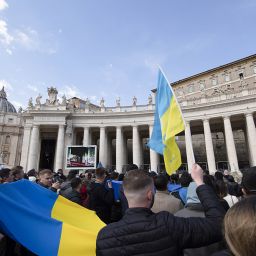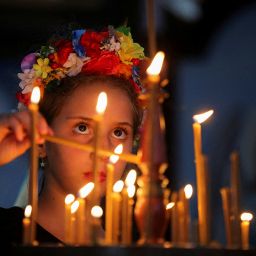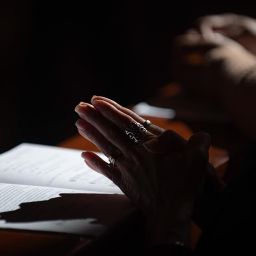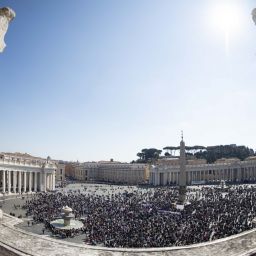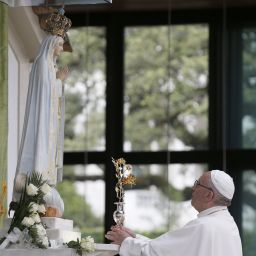
By Father Jacob Dankasa
Special to The Texas Catholic
When the Lord appeared to two of his followers on their way to Emmaus, it was obvious that the men were cold, disappointed, and confused about all that had happened in recent times, especially the crucifixion of the man called Jesus. They were at a loss as to what they could do now that he was no more. And even though they had heard rumors of his rising, they couldn’t verify that they were true. This was a cold moment, a moment of decision. Should they continue to believe in the teachings of a man who had died, or begin a different way of life? It’s obvious that the discouragement of these two disciples at this point far outstripped their hope.
But when Jesus appeared and explained the scriptures to them, opened their hearts to understanding those scriptures, and then opened their eyes through the breaking of the bread, these confused disciples received a renewed vigor of heart and spiritual insight. They recognized Jesus in the sharing of the word and the breaking of the bread. They exclaimed: “Were not our hearts burning [within us] while he spoke to us on the way and opened the scriptures to us?” (Lk. 24:22). We are told that after their encounter and interactions with Jesus these two men made a U-turn and returned to join the other disciples in Jerusalem. They didn’t remain in Emmaus, but returned to Jerusalem with good news and testimony.
The road to Emmaus as it is today is not just a street somewhere in Israel. Cardinal Timothy Dolan tells a story about his pilgrimage to the Holy Land. He said at the end of his pilgrimage, but before he returned to the U.S., the Franciscan who guided his tour asked him if there was anything else he wanted to see. The Cardinal replied that he would like to walk the road to Emmaus. To the disappointment of the Cardinal, the guide replied that no one knows for certain where the village of Emmaus really was. Therefore, there is no more road to Emmaus. But, seeing the disappointment of the Cardinal, the Franciscan guide added: “Maybe that’s part of God’s providence, because we can now make every journey we undertake a walk down the road to Emmaus. (See the book: Encountering Jesus by Peter J Vaghi, p.78-79.)
Considering the Emmaus story in the present-day realities of faith, the two disciples on their way to Emmaus were probably going to a land of hopelessness. They left Jerusalem and the other disciples because there was no reason to stay there: the master was no more, and the faith they had believed in was failing. Their faith was declining. As we have observed, these two disciples didn’t remain in Emmaus after encountering Jesus; they returned to Jerusalem because their faith was restored by the encounter. Thus, for us Emmaus represents a spiritual place where people who give up hope go, a place of loss and discouragement.
In our world today, many of our young Catholics are travelling this path to Emmaus, journeying toward hopelessness and discouragement in faith and religion. They’re confused, and they’re seeking answers to the many misguided questions that the world poses from every angle. They seek answers and guidance. We need to help them create an avenue of encounter with the Lord in their journeys — we need to personally accompany them on this journey. In his post-synodal exhortation on youths, “Christ is Alive,” Pope Francis reminds us that we’re capable of helping people who don’t understand the faith, doubt God or even have abandoned the faith to begin or resume their faith journey. We shouldn’t be afraid to accompany others, especially young people who are still in doubt about the Church and Christian teachings, or who even disagree with them.
One very important thing we can do is help our young ones to have a clear understanding and appreciation of the real presence of Jesus in the Eucharist. When the two disciples encountered Jesus on their way to Emmaus, their hearts burned within them. Every time we experience the celebration of the Eucharist we enter into an Emmaus experience: Jesus feeding our hearts with His word and filling our souls with His presence through the sacrament of His body and blood. Every Mass is a new experience of Emmaus. In it we encounter the living Jesus taking a walk with us and setting our hearts on fire with passion to live out our faith journey with courage, strength and renewed vigor in the service of the Lord.
Our young Catholics need our support and guidance to have a renewed appreciation of the Eucharist. Many of them are travelling this proverbial road to Emmaus – the land of discouragement, abandonment and surrender to a faithless generation, a path toward confusion and hopelessness in their faith. They need faithful and spirit-filled companions. They might struggle with questions, and even misunderstandings, about the faith. Perhaps they feel discouraged about the Church, and may even be feeling that Christianity or Catholicism is not cool enough. We need to be the Jesus that meets them on their way, explaining the scriptures to them, explaining the faith to them, and helping them see meaning in the real presence of Jesus in the Eucharist. We need to help break open the Word of the Lord for them and teach them so that their hearts and eyes can see Jesus. Then, like those disciples of long ago, they can make a U-turn and come back home to remain in the Church, where Jesus is.
To this end, I want to encourage parents to teach the faith in their homes. I also encourage our parishes and parents to support our young Catholics at every level to participate in the various faith formation and youth programs organized in our churches, and to also strongly encourage them to attend some of the life-changing conferences organized for our Catholic youths, conferences like the Dallas Catholic Youth Conference (DCYC) and the Lone Star Steubenville Conference.
Let’s together redirect our hearts and those of our young Catholics from Emmaus to Jesus.
Father Jacob Dankasa is the pastoral administrator of Holy Family of Nazareth Catholic Church in Irving.


